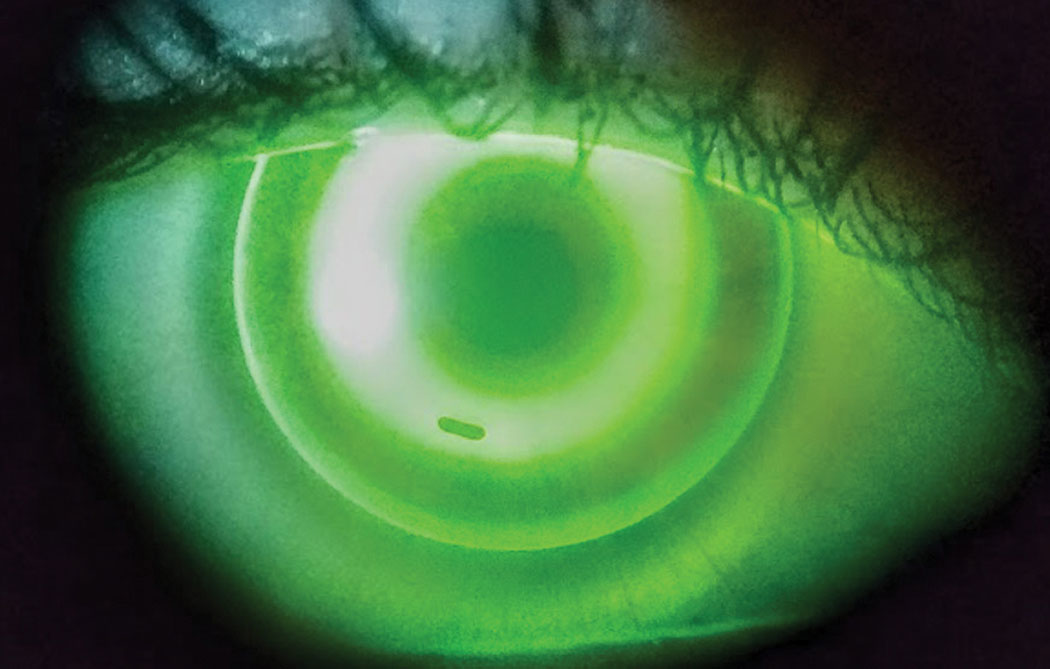 |
An ortho-k lens design with smaller back optical zone diameter may offer faster visual improvement for myopes. Photo: Dan Fuller, OD. Click image to enlarge. |
While it is now generally understood that an orthokeratology (ortho-K) lens design with smaller back optical zone diameter might yield a faster myopic reduction and a smaller aspheric treatment zone, previous studies have used methods to calculate corneal refractive power change in ortho-K by collecting data at certain points along two corneal meridians or by adding the corneal refractive power within a certain area to generate cumulative corneal refractive power change. Researchers in China recently found that using polynomial function in modeling relative corneal refractive power change yielded reasonably good fitting of curves. It reserved as much topographical data as possible compared with the previous methods.
The study assigned 65 participants to four groups:
(1) lens with 6.2mm back optic zone diameter, patient younger than 14
(2) lens with 6.2mm back optic zone diameter, patient older than 14
(3) double tear reservoir lens with 5.0mm back optic zone diameter
(4) double tear reservoir lens with 6.0mm back optic zone diameter
Manifest refraction and corneal topography were checked at baseline and one day, one week, two weeks and one month after lens wear. Relative corneal refractive power change was calculated by a polynomial function and a monomial function.
Corneal refractive power change across different visits were combined and fitted with a polynomial function using the formula y = Ax + Bx2 + Cx3 + Dx4+…+Nxn (where x is the distance from the corneal apex and y is corneal refractive power change). The maximum relative corneal refractive power change (Ymax) and the corresponding distance from the corneal center (Xmax) were analyzed. The Y values corresponding to 1/4 Xmax, 1/2 Xmax and 3/4 Xmax were defined as 1/4 Ymax, 1/2 Ymax and 3/4 Ymax, respectively, and calculated accordingly.
To illustrate the spatial distribution of corneal refractive power change in a straightforward way, the relationship between corneal refractive power change and its corresponding corneal radial distance were assessed using a monomial function of the form y=xn (where x is the radial distance from the corneal apex, n is the power exponent and y is corneal refractive power change). A lower power exponent represented a higher asphericity of the treatment zone.
Results
The researchers found a significant impact of different ortho-K lens designs on the spatial distribution of relative corneal refractive power change after corneal reshaping, especially in the midperipheral zone close to the corneal apex. Refractive reduction and central corneal flattening was seen at all follow-up visits after ortho-K lens wear, fastest in the 5.0mm back optic zone diameter group. The cornea steepened in an aspheric way toward the midperiphery and peaked at approximately 2mm to 3mm off the apex. Overall, Ymax was not different among the four groups, but Xmax was smallest in the 5.0mm back optic zone diameter group.
At 1/2 Xmax, the relative corneal refractive power change with the 5.0mm back optic zone diameter design was significantly larger than that of the other three groups. The power exponent of the monomial of the 5.0mm back optic zone diameter design was greater than that of the other three groups.
The study team noted that they believe previous methods were less effective in interpreting the detailed profile of corneal refractive power change (e.g., spherical vs. aspheric) within the treatment zone, thereby confounding the elements that are responsible for the individual variation in myopia control effect after ortho-K treatment. Their study could enhance understanding of the effects of ortho-K lens design on corneal profile.
“By analyzing the detailed data,” the researchers wrote in their paper, “we found that lenses with a smaller back optical zone diameter (5.0 mm) tended to induce a smaller (≈2.0mm) and more aspheric treatment zone than those of the other two lens designs (2.5-3.0mm), meaning that the cornea steepened faster towards the mid-periphery and reached maximum in relative corneal refractive power change at a smaller corneal radial distance in the 5.0 mm back optical zone diameter group.” They concluded that “these results offered a possibility of optimizing ortho-K lens designs for better myopia control efficacy.”
Zhang Z, Chen Z, Zhou J, et al. The effect of lens design on corneal power distribution in orthokeratology. Optom Vis Sci. March 12, 2022. [Epub ahead of print]. |


